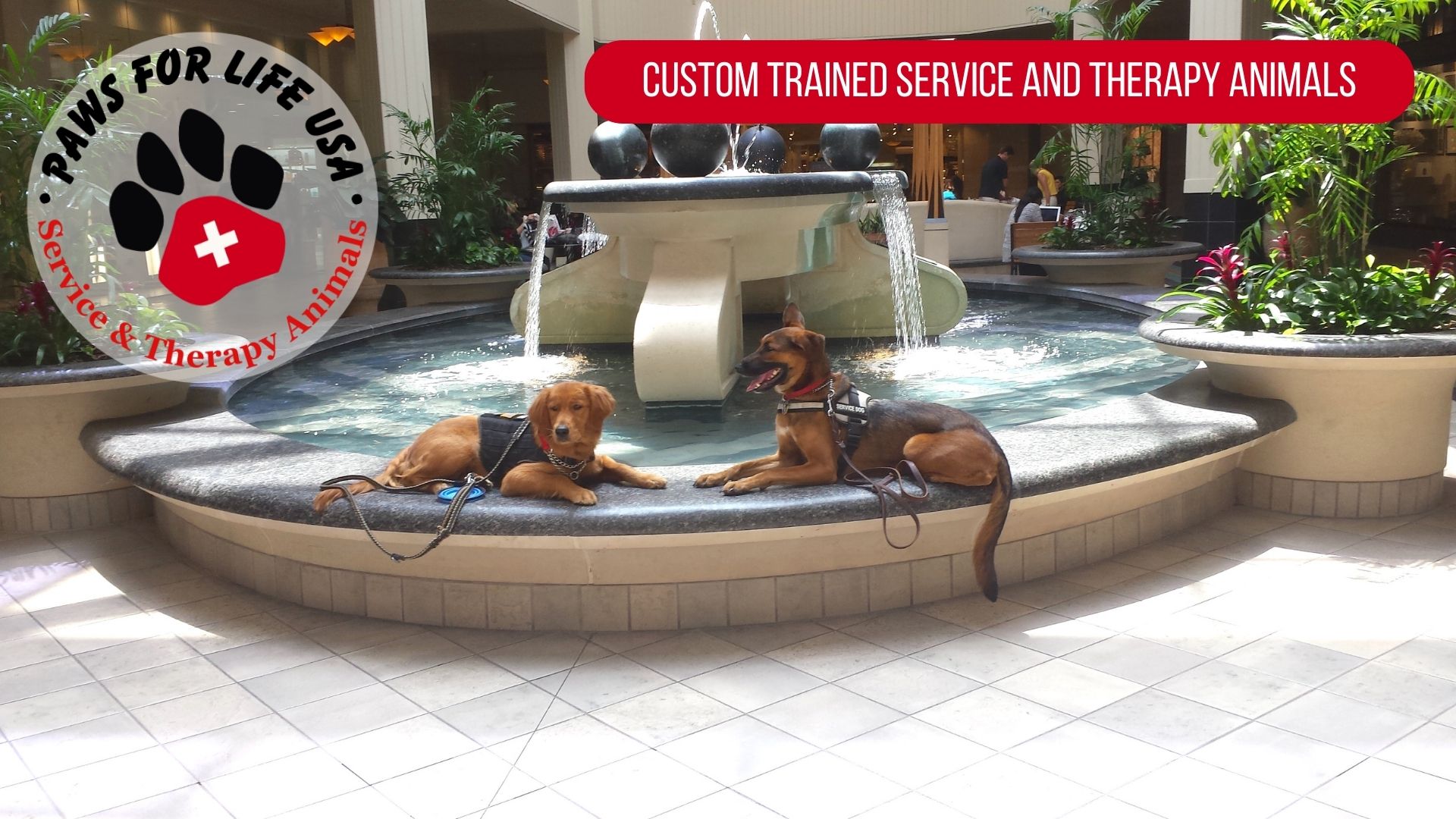Episodic Disorder Service Dogs (Epilepsy, Meniere, Narcolepsy, Migraine)
Episodic diseases present with symptoms that affect all areas of life. One of the most debilitating of these symptoms are: the “episodes” associated with these diseases. For example:
 • Seizures
• Seizures
• Migraines
• Fainting Spells
• Falling asleep
It is these experiences that often place enormous restrictions on the individual and produce much anxiety. The individual often does not know when the episode will occur and consequently their safety becomes jeopardized. If a fainting spell or seizure occurred while driving or crossing the street, the situation could be fatal. Work can become difficult as tasks or presentations become interrupted during these episodes and the response of the co-workers can cause embarrassment and isolation for the individual. Even something as simple as a staircase can become a complete restriction. Service dogs can re-open these activities and environments to the individual.
THE GOAL: Episodic disorders present a unique complication to the individual and the service dog trainer. The goal of episodic service dogs is that through training and exposure the dog will be able to alert to impending episodes, allowing the individual to seek safety or take rescue medication. Not all dogs can accomplish this. Trainers and science have yet to isolate the warning factors in episodic diseases. However, even if the dog never learns to “alert”, they provide many safety and comfort tasks during and after each episode.
1. The service dog can roll the person into the “left side recovery position” after a seizure. 2. They can go seek help for the person. 3. Service Dogs provide grounding and comfort as the person arouses from these episodes. 4. The service dog can also carry the rescue medication and medical information so that others will be able to understand what is happening and assist as necessary.
Seizures
All dogs seem to be able to predict seizures. Approximately fifteen percent of dogs are naturally able to predict seizures before they occur. On average, these predictions or alerts are made 10-20 minutes before the seizure, giving the person with the seizure disorder an opportunity to move to a safe place, take medication, call for help, or notify friends or family of the impending seizure so they can be checked later. Success may depend on the type of seizures the owner is having. Psychological seizures are induced by stress and epileptic seizures cause a change in the chemistry in the brain. For some seizure suffers, having an alert dog can lead to less frequent seizures. Further research still needs to be done in all these areas.
No one knows for certain how these dogs are able to detect when a seizure is about to occur. Two popular theories are (1) that the dog is able to smell minute changes in the person’s biochemistry; possibly in their blood chemistry or (2) that they are able to detect fine motor changes imperceptible to human eyes. Regardless of how precisely they do it, this behavior is a natural one that occurs in some dogs and not others. It may take a dog with this innate ability up to six months living with a person with a seizure disorder to begin displaying the ability. Programs that place seizure response dogs have reported that about half of the response dogs they place go on to alert as well within six months of placement.
Some trainers believe that you cannot train a dog to alert to a seizure but we believe differently. We teach our seizure dogs a game specifically to be played with their handlers to train them to alert to oncoming seizures. Yet, once a recipient and their dog develop a strong bond, many seizure response dogs (about 87%) do go on to PREDICT or react in ADVANCE of a seizure, usually with an unusual behavior, such as whining, pawing, pacing, jumping, barking, etc. This may happen a few to several minutes before a seizure, which can be quite helpful for individuals who do not experience an aura or feeling that the seizure is coming on. We train our dogs to respond with manners that are unique to them.
Seizure alert/response dogs Other dogs, called seizure response dogs, are trained to perform tasks during or following a seizure to assist the owner. These tasks may include rolling the person to create an open airway, clearing vomitus from the mouth, getting help, operating a call button or k9 phone, blocking the person with postictal disorientation from stairs and intersections, helping the person to rise, helping with postictal balance issues, guiding the disoriented person to a preset location or person, et cetera. Because these response tasks are so useful, most seizure alert dogs are also trained in response work. These dual seizure dogs are called “seizure alert/response dogs” or simply “seizure dogs.
Even if a service dog does not learn to alert to a seizures, their handler can still benefit from the dog as s/he can stay with the person and comfort them as they recover (by lying beside them), lick them as they re-orient or go get help as the seizure is happening (or the other tasks listed above). Of course, seizure response dogs offer constant emotional support as well.
Of course, training a seizure response dog is more complicated than simple behavior conditioning. In order to be a valid service dog, the dog also needs to have all the foundation behaviors, such as basic obedience, being calm in public, ignoring distractions like food, kids, other dogs, cats, and people plus we recommend to have at least 3 specially-trained behaviors such as responding to the seizure by providing comfort, getting help, pressing an emergency alarm, dragging harmful objects away from the person as they are having a seizure, carrying information about the handler’s medical condition, rolling them over to prevent airway blockages, blocking the person from falling down stairs, helping to re-orient the person as they come out of their seizure, helping the person to stand after a seizure (called bracing), guiding their disoriented person to a predetermined location for help, or reminding their person to take their medication regularly.
Types of Seizures
There are many different types of seizures. Some seizures, such as many temporal lobe seizures, build gradually, with seizure activity building slowly over time. This allows an advanced warning system for a dog to recognize a scent cue and alert in advance before the seizure ‘breaks through’ with the visible signs of a seizure. Some seizures, such as many frontal lobe seizures, strike quickly like lightening and many do not have a gradual increase of seizure activity. In some of these cases, with frontal lobe seizures, it is impossible for a dog to alert in advance because there is no seizure activity within the brain that the dog can detect – but dogs can still be taught to alert during the seizure which can assist in the form of the dog alerting another household member of their recipient’s seizure. Many detailed factors come into play which can determine if a dog is able to alert in advance of a seizure, or during a seizure. Every case is different based on the types of seizures the disabled party experiences, how often these seizures occur, and when these seizures occur. We will need to speak with you and your neurologist to have a full understanding of your seizures. This allows us to determine what is possible to make sure you have a realistic expectation of how a dog can assist.
Seizure Assistance
Our dogs are also trained to assist after a seizure. They are trained to locate and retrieve a phone for their handler to call for help if needed. They are also trained to help brace or balance their handler for stability after a seizure. In certain cases recipients will ask that the dog be trained to retrieve a family member in another room.
Seizure Assistance and Alert Dogs for Children and Infants
Because of our alert game we can train the dog to alert a parent that their child is going to have a seizure. No more worrying! It is such a relief for parents to know when their child will have a seizure. But please understand that no one or no dog is 100% there are a lot of factors that can be present at any time day or night to prevent a full alert.
Narcolepsy
Additional Information on Service dogs for narcoleptics:
Service dogs cannot predict cataplexy attacks like many who predict epileptic seizures. Epileptics brains actually give off signals ahead of an actual seizure, and a seizure alert dog senses those signals and are taught to tug on their owner (or exhibit some kind of sign) to warn them. Cataplexy does not cause the brain to give off any kind of warning signs.
Of course, if laughter or some very specific things trigger your attacks, in time you can teach your dog to recognize that whenever you laugh, you’ll have an attack. Not really all that helpful, though, because for most of us an attack comes immediately after or during the triggering event. And no, your service dog doesn’t keep you awake while driving. Especially since they belong in the back seat of your car, and have no way to even know if you are falling asleep.
The only way you can get a dog to wake you when you’re sleeping (when you need to get up for work, etc), you can train your dog to wake you when your alarm goes off and you don’t awaken to that. The dog would hear the alarm and pull the covers off you. But that in itself would not allow a dog to be a service dog.
If one lives alone, does errands alone, go to appts. Alone or when in public, should you have a cataplexy attack, your dog becomes a medical alert dog, meaning that if you are found collapsed and unresponsive, with your dog lying beside you, you are easily identified as having a medical condition and your dog wears a medical alert laminated card that hangs from her vest (along with her certification) that explains what is happening to you, and what to do, and more importantly, what not to do.
Your dog becomes what is referred to as cross-trained, meaning your dog is trained to do a multitude of things and when a recipient gets their dog, they use the commands that are specific to their disability.


